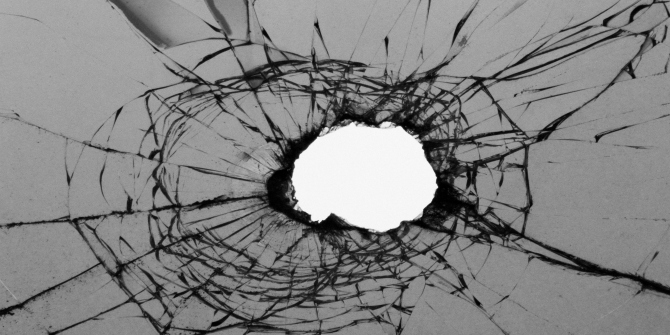As the notion of ‘collateral damage’ – or the unintentional yet foreseen killing of civilians in war – has come to shape contemporary military conflict, Frederik Rosén undertakes a historical examination of its evolution, place and role in modern warfare. Collateral Damage: A Candid History of a Peculiar Form of Death offers a timely and intellectually engaging investigation of the historical, conceptual and philosophical underpinnings of this highly controversial, yet ostensibly legalised form of killing, writes Alexis Bushnell.
Collateral Damage: A Candid History of a Peculiar Form of Death. Frederik Rosén. Hurst. 2016.
 Part of a series on Critical War Studies, Frederik Rosén’s exploration of collateral damage examines the phenomenon of a legal form of killing. At the opening of Collateral Damage: A Candid History of a Peculiar Form of Death, Rosén offers a definition of collateral damage as adhered to by the United States Department of Defense:
Part of a series on Critical War Studies, Frederik Rosén’s exploration of collateral damage examines the phenomenon of a legal form of killing. At the opening of Collateral Damage: A Candid History of a Peculiar Form of Death, Rosén offers a definition of collateral damage as adhered to by the United States Department of Defense:
Collateral Damage is the unintentional or incidental injury or damage to persons or objects that would not be lawful military targets in the circumstances ruling at the time. Such damage is not unlawful as long as it is not excessive in light of the overall military advantage anticipated from the attack.
The work demonstrates how collateral damage as a concept originated and has become solidified, questioning the validity and ethics of this throughout. Using examples and cases as seemingly disparate as accounting in medieval monasteries and the case of the Ford Pinto, Rosén displays the tapestry of ideas and concepts that form our understanding of collateral damage. The book is well-timed as collateral damage is a demonstrated part of the legacy, and indeed, a continuation of covert and overt military operations as part of the worldwide ‘War on Terror’, counterinsurgency operations and the conflict in Syria among many others.
The first part of the book discusses collateral damage through contemporary Western warfare, followed by an examination through the lens of law. Responsibility surrounding collateral damage is explored through international human rights law and international humanitarian law (IHL) and their respective justice mechanisms. This discussion should be of interest to academics, practitioners and students of law, as well as to military personnel. Rosén’s analysis is contemporary and timely, particularly in examining the use of drones and the way this may affect engagement with the principles of IHL.
Subsequently, Rosén draws out the historical, philosophical and conceptual underpinnings that help explain the rise of our contemporary understandings and acceptance of collateral damage. He thoughtfully takes us through a discussion of the role of Manichean principles of good and evil, theodicy (the question of why God permits evil) and just war theory, and brings us to an engaging discussion regarding utilitarianism. For example, a theocratic understanding of human suffering from Enlightenment thinkers is argued by Rosén as being comparable to collateral damage today through an explanation of the Lisbon earthquake in 1775. Rosén writes that: ‘in the intellectual aftermath [of the earthquake], the great enlightenment thinkers, including Voltaire, Rousseau and Kant, reopened the trial of God by revisiting the writings of Gottfried Wihelm von Leibniz on the theodicy problem. His elaboration of the theodicy problem had addressed the resolution of the existence of anguish in a world that is ruled by an almighty and inherently good god. Leibniz’s theodicy was another theological and philosophical defence of a God who had already faced severe legitimacy problems amidst the hunger, plagues and wars of the middle ages.’
Rosén goes on to state that ‘[i]n a nutshell, theodicy may be viewed as a struggle to bridge the gap between promise and performance that has haunted the image of God – very similarly to the way it has, in modern times, haunted the state’ (96).
 Image Credit: Crop of ‘broken glass’ by Mario A.P. licensed under CC BY SA 2.0
Image Credit: Crop of ‘broken glass’ by Mario A.P. licensed under CC BY SA 2.0
The role of sacrifice and heroic notions of war are central to Rosén’s discussion, followed by an examination of accidents. This takes the reader through Aristotelian and theological understandings, drawing this through to the industrial revolution and a modern understanding of accidents and the role of responsibility. Rosén explains that ‘what moves accidents into the subset of collateral damage is a certain political claim that inscribes the accidents into the domain of governance’ (129), arguing that collateral damage should therefore be understood as a claim rather than as a description.
In the final act of the book, the argument that collateral damage depends upon a central legitimised authority, be it the State or God, is solidified and explored. When discussing authority, Rosén turns to the dichotomy of public vs private organised violence. He does this through an examination of the case of the Ford Pinto, whereby the car’s defective fuel system led to the largest recall in automotive history in the 1970s due to related fatalities and injuries. Rosén explores the public perception of the role of private companies in identifying forms of collateral damage, as opposed to this being determined by centralised government. He writes that there is an obsession with the monopoly of force in the hands of the state, which ‘prevents us from seeing clearly what is actually at stake in the privatisation of violent force which is, essentially, a Judeo-Christian vision of centralised authority, including the connection between authority and the claim to collateral damage’ (139). This argument is rounded out through a fair discussion on mercenaries throughout the centuries, and private military services as they are used contemporarily.
While sections of Collateral Damage may be esoteric, it is indeed a very interesting and intellectually engaging work. This book will be of interest to those in law, politics, policy, human rights, philosophy, theology and history, among other disciplines. It is also of the utmost importance to those whose lives may be viewed through the lens of collateral damage, and to those who are part of the authority that determines these lives. Rosén’s work provides us with a much-needed point of departure from other discussions of the subject. As he aptly notes, when it comes to collateral damage, ‘[w]e are talking about severe physical sensation, humans decomposing in raw pain. Not a social construction.’
Note: This review gives the views of the author, and not the position of the LSE Review of Books blog, or of the London School of Economics. The LSE RB blog may receive a small commission if you choose to make a purchase through the above Amazon affiliate link. This is entirely independent of the coverage of the book on LSE Review of Books.







